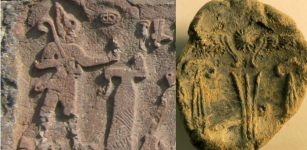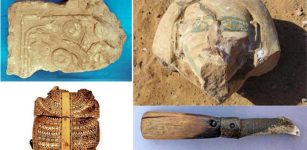Coyote – Native American Trickster, Creator, And Sacred Animal Who Can Deceive But Also Give Wisdom
A. Sutherland - AncientPages.com - Coyote, the trickster-god, is a well-known figure in myths and legends of Indigenous peoples of North America.
Coyote, a mischievous, cunning, and destructive force at work within creation, was also assigned to the role of god-deceiver, a great cheater who misleads people and animals and finds obvious pleasure in causing troubles and upsets daily.
Credit: Adobe Stock - Yevhenii
Coyote Can Deceive And Be Reckless
Among the many tribes of Native Americans, there is a belief that the Coyote is the bearer of all evil and brings winter and even death. The Maidu people of northern California, for example, portrayed the Coyote as deceitful, greedy, and reckless, and these evident failings in his character make problems for people around him. His impulsive and foolish behavior causes him to suffer, too. Frequently, he is killed through his carelessness, but, in some way, amazingly, he always comes back to life afterward.
Still, the Coyote remains a very prominent animal. The basis of his character is the same in all myths; only a few character traits of Coyote vary from region to region.
Coyote Can Share Priceless Wisdom With People
Other tribes claim the opposite and believe Coyote is the teacher of wisdom, the trickling god, who - when properly approached - can share with people some priceless wisdom.
Many Native myths deal with this amazing creature, the most sacred and, at the time, most profane of animals. Coyote's power is to make people free or to feel fear.
Coyote is a sacred animal among Native Americans. Credit: Adobe Stock - Mircea Costina
Among many Native American tribes, the Coyote is credited with bringing humanity the gift of fire, the destruction of monsters, the making of waterfalls, and the teaching of useful arts to the Indians. But perhaps the most famous and fascinating incarnation of this remarkable creature is presented in the Nez Perce tribe's myth of Coyote and the Shadow People. His actions lead to humankind being forever separated from the spirit realm of the dead.
Coyote Shows Us How Ridiculous We Can Be Sometimes
As we look deeper into Coyote's character, we realize that the creature's cunning tricks are not always trivial. His mischief is not so much to deceive us from our goal as to show how ridiculous we often are in our lives and suggest we have to take a bit of distance from ourselves and think about what we really do with our lives.
Unlike the Coyote, we cannot come back to life if we are killed. Looking at Coyote's foolishness, we can avoid making mistakes and find a straight road with a purpose.
Coyote is sometimes a Creator and sometimes a clown, destroying things for himself and others who surround him.
Because of his vanity and boastfulness, the Coyote undertakes various ambitious enterprises, in which he fails due to his passions.
Is it not the same we experience our lives sometimes?
Coyote And Other Tricksters In Mythology
Coyote has been compared to both the Scandinavian Loki, and also Prometheus, who shared with Coyote the trick of having stolen fire from the gods as a gift for mankind, and Anansi, the great trickster of West African legend, who was originally credited with the creation of the world and became a cultural founder hero.
In the Aztec pantheon of gods, the trickster and transformer, Ueuecoyotl or Huehuecóyotl ("Old Coyote"), shares many characteristics with the trickster Coyote of the North American tribes.
In Eurasia, rather than a coyote, a fox is often featured as a trickster hero. For example, in Japanese mythology, he is known as kitsune, and in medieval European folklore, there is a similar figure known as Reynard the Fox.
Updated on January 7, 2024
Written by – A. Sutherland AncientPages.com Staff Writer
Copyright © AncientPages.com All rights reserved. This material may not be published, broadcast, rewritten or redistributed in whole or part without the express written permission of AncientPages.com
Expand for referencesReferences:
Alexander, Hartley Burr. The Mythology of All Races
Sun Bear, Wabun Wind, Crysalis Mulligan, Dancing with the Wheel
D. Moses, Pursued by a Bear: Talks, Monologues and Tales
More From Ancient Pages
-
 Were Owl-Shaped Plaques Children’s Toys In Copper Age?
Archaeology | Dec 1, 2022
Were Owl-Shaped Plaques Children’s Toys In Copper Age?
Archaeology | Dec 1, 2022 -
 What Is Pax Sinica?
Ancient History Facts | Apr 26, 2018
What Is Pax Sinica?
Ancient History Facts | Apr 26, 2018 -
 Feared Skinwalker – Shapeshifter That Uses Mind Control To Hurt Victims In Native American Mythology
Featured Stories | May 16, 2019
Feared Skinwalker – Shapeshifter That Uses Mind Control To Hurt Victims In Native American Mythology
Featured Stories | May 16, 2019 -
 Vettuvan Koil Temple Spectacular Monolith Dedicated To Lord Shiva And Built By Pandya Dynasty
Featured Stories | May 25, 2021
Vettuvan Koil Temple Spectacular Monolith Dedicated To Lord Shiva And Built By Pandya Dynasty
Featured Stories | May 25, 2021 -
 Why Are Christmas Ghost Stories So Fascinating?
Christmas Traditions | Dec 24, 2019
Why Are Christmas Ghost Stories So Fascinating?
Christmas Traditions | Dec 24, 2019 -
 A Ptolemaic Mummy Reveals Evidence Of Dental Filling Used In Ancient Egypt
Archaeology | Aug 6, 2020
A Ptolemaic Mummy Reveals Evidence Of Dental Filling Used In Ancient Egypt
Archaeology | Aug 6, 2020 -
 Uncovering 16th Century Scottish Royal Dockyards Used By King James IV’s Navy
Archaeology | May 24, 2018
Uncovering 16th Century Scottish Royal Dockyards Used By King James IV’s Navy
Archaeology | May 24, 2018 -
 Peculiar Accounts Of Ancient Flying Metallic Dragons And Bells In China And Japan
Ancient Mysteries | Dec 27, 2018
Peculiar Accounts Of Ancient Flying Metallic Dragons And Bells In China And Japan
Ancient Mysteries | Dec 27, 2018 -
 Restoration Of Valuable 4th Century Silk Tunics Attributed To St. Ambrose Takes Place In Milan
Artifacts | Apr 12, 2017
Restoration Of Valuable 4th Century Silk Tunics Attributed To St. Ambrose Takes Place In Milan
Artifacts | Apr 12, 2017 -
 Ancient Clay Seals That Could Re-Write Hittite History Discovered In Kayalıpınar, Turkey
Archaeology | Sep 14, 2023
Ancient Clay Seals That Could Re-Write Hittite History Discovered In Kayalıpınar, Turkey
Archaeology | Sep 14, 2023 -
 Three Punic Wars Between Rome And Carthage Lasted Almost A Hundred Years
Featured Stories | Apr 29, 2019
Three Punic Wars Between Rome And Carthage Lasted Almost A Hundred Years
Featured Stories | Apr 29, 2019 -
 New Interpretation Of The Domesday Book Of William I The Conqueror
News | Jan 16, 2021
New Interpretation Of The Domesday Book Of William I The Conqueror
News | Jan 16, 2021 -
 Mystery Of Lady Of Elche – Puzzling Artifact Of An Unknown Queen Or Priestess
Ancient Mysteries | May 22, 2014
Mystery Of Lady Of Elche – Puzzling Artifact Of An Unknown Queen Or Priestess
Ancient Mysteries | May 22, 2014 -
 20 Mummies Discovered In Greco-Roman Tombs In Aswan, Egypt
Archaeology | Jan 21, 2022
20 Mummies Discovered In Greco-Roman Tombs In Aswan, Egypt
Archaeology | Jan 21, 2022 -
 Mystery Of The 3,500-Year-Old ‘Screaming Woman’ Mummy Solved
Archaeology | Aug 9, 2024
Mystery Of The 3,500-Year-Old ‘Screaming Woman’ Mummy Solved
Archaeology | Aug 9, 2024 -
 On This Day In History: 150 Highly-Trained Swiss Guards Entered Vatican For The First Time – On Jan 22, 1506
News | Jan 22, 2017
On This Day In History: 150 Highly-Trained Swiss Guards Entered Vatican For The First Time – On Jan 22, 1506
News | Jan 22, 2017 -
 The Man Who Took The Greatest Alchemy Secret Of All Time To His Grave
Ancient Mysteries | Jul 16, 2020
The Man Who Took The Greatest Alchemy Secret Of All Time To His Grave
Ancient Mysteries | Jul 16, 2020 -
 Neanderthals Had Older Mothers And Younger Fathers Compared To Modern Humans
Archaeology | Apr 23, 2020
Neanderthals Had Older Mothers And Younger Fathers Compared To Modern Humans
Archaeology | Apr 23, 2020 -
 Strange Flat Idol Sculpture From Bactria Remains Unexplained
Artifacts | Sep 26, 2019
Strange Flat Idol Sculpture From Bactria Remains Unexplained
Artifacts | Sep 26, 2019 -
 Weapons Of Ancient Aztec Warriors Of Mesoamerica
Featured Stories | Mar 23, 2017
Weapons Of Ancient Aztec Warriors Of Mesoamerica
Featured Stories | Mar 23, 2017


